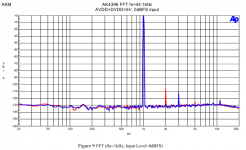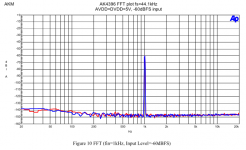Sounds like another cargo cult project. Aren’t there already dozens of commercial DACs, using current production DAC chips, that claim to be the ultimate in audio reproduction? What makes your approach different? You haven’t even settled on an analog stage technology or established an over-arching design philosophy, just a lot of sound-good, advertising jargon. Wow, gold-plated XLR pins: That will really make your DAC stand out from all the rest.
Why insist on current production parts? Some the most highly regarded 2-channel DACs use TDA1541A, AD1865, and PCM1704. If you want an 8-channel DAC that is as good as the best stereo DACs, just parallel 4 of the best stereo DACs. The logic needed to split an 8-channel signal into four, synchronized stereo pairs is trivial.
Why insist on current production parts? Some the most highly regarded 2-channel DACs use TDA1541A, AD1865, and PCM1704. If you want an 8-channel DAC that is as good as the best stereo DACs, just parallel 4 of the best stereo DACs. The logic needed to split an 8-channel signal into four, synchronized stereo pairs is trivial.
Sounds like another cargo cult project. Aren’t there already dozens of commercial DACs, using current production DAC chips, that claim to be the ultimate in audio reproduction?
Sure. Anyone can claim, few can deliver.
What makes your approach different?
Not making any claims will do as a distinctive start.
I agree... why don't we look at taking the best stereo DAC or its design parameters (of course there will be a debate on which is the best and the opinion will vary widely) and incorporate the circuitry needed for the Asynchronous buffered USB to split the 8 channels out (in a modular manner) and give a fully differential balanced output for all channels.
I think the 96khz sampling and down-sampling of anything higher will be not well received today considering most top stereo DACs have moved to 384kHz territory... and even this top PCM sampling is not going down well with those who consider the MHz level sampling rates of DSD to be barely sufficient.
If our DAC isn't going to handle DSD - then we lose interest from quite a few audio enthusiasts...
By ultimate I mean both in ear and on paper...
The idea of a preamp with no need for external power - just seems so good to pass-up
6moons audio reviews: Music First Audio Passive Magnetic Preamplifier
Can someone tell me why a magnetic pre-amp couldn't/shouldn't be used to bring the DAC output to line level?
I think the 96khz sampling and down-sampling of anything higher will be not well received today considering most top stereo DACs have moved to 384kHz territory... and even this top PCM sampling is not going down well with those who consider the MHz level sampling rates of DSD to be barely sufficient.
If our DAC isn't going to handle DSD - then we lose interest from quite a few audio enthusiasts...
By ultimate I mean both in ear and on paper...
The idea of a preamp with no need for external power - just seems so good to pass-up
6moons audio reviews: Music First Audio Passive Magnetic Preamplifier
Can someone tell me why a magnetic pre-amp couldn't/shouldn't be used to bring the DAC output to line level?
Well if you're concerned about 'being well received' this isn't compatible with aiming for the stars in terms of SQ. Also DSD is a flawed medium due to noise modulation, so not worth having as a feature in an ultimate DAC. It'll be a major distraction - but might be worth doing as a separate project 'Ultimate DSD DAC'.
I'll check out the 6moons link.... OK, its cool, I'm a big fan of transformers. But I can't think why a TVC is needed inside a DAC. You're assuming that a DAC output isn't already line level. But why wouldn't it be designed to be?
I'll check out the 6moons link.... OK, its cool, I'm a big fan of transformers. But I can't think why a TVC is needed inside a DAC. You're assuming that a DAC output isn't already line level. But why wouldn't it be designed to be?
Last edited:
We are aiming for the best SQ and specs - if they are in any way mutually exclusive... we should try for both to the extent possible...
if you are saying that higher sampling rates actually causes more noise issues or difficulty in maintaining sound quality... then please explain how and to what extent...
I thought the original reason for going with lower sampling rates (not for mastering but in publishing and distributing content) was the need to maintain a reasonable file size for the media available at the time.
CDs could only store so much - then came BluRay which can store 6 or 8 channel surround audio or even 3D audio at 24bit/192kHz or higher...
Its only a matter of time before a compression/storage and distribution medium will be finalized for 4k video and since video technology changes and adoption are going to be faster than audio - that is where a multi-channel DAC (which processes PCM to the best sampling) is needed and should shine.
I see no point in handling only 96khz for which there are existing mixers and other DAC options on AV receivers and such...
if you are saying that higher sampling rates actually causes more noise issues or difficulty in maintaining sound quality... then please explain how and to what extent...
I thought the original reason for going with lower sampling rates (not for mastering but in publishing and distributing content) was the need to maintain a reasonable file size for the media available at the time.
CDs could only store so much - then came BluRay which can store 6 or 8 channel surround audio or even 3D audio at 24bit/192kHz or higher...
Its only a matter of time before a compression/storage and distribution medium will be finalized for 4k video and since video technology changes and adoption are going to be faster than audio - that is where a multi-channel DAC (which processes PCM to the best sampling) is needed and should shine.
I see no point in handling only 96khz for which there are existing mixers and other DAC options on AV receivers and such...
Last edited:
I suggest you go over to Lavry Engineering and read some of Dan's white papers. Dan's one of the few guys not taken in by all the marketing spin around digital audio.
Last edited:
its only a matter of time before Lavry's next iteration of products will go to 192kHz... may be once everyone else has moved to 384kHz and beyond?
They assert that "Increasing the sample frequency beyond 96 kHz will degrade the conversion accuracy in the audio frequency range" - even in the recording and mastering process...not just playback.
is this assertion based on the AD chips performance characteristics... How did they verify the degradation of the recording due to a higher sample rate?
They assert that "Increasing the sample frequency beyond 96 kHz will degrade the conversion accuracy in the audio frequency range" - even in the recording and mastering process...not just playback.
is this assertion based on the AD chips performance characteristics... How did they verify the degradation of the recording due to a higher sample rate?
Last edited:
Demonstrating a single tone without noise modulation artifacts does not guarantee no noise modulation with a typical D-S DAC. What's the DAC chip used in your soundcard?
Here's a bigger plot where I can make out the scales
Is this your result? Looks like AP result. Apparent noise floor is below -150dB, suggestive of more than 24bits. This is likely not the case.
Here are two results with 19kHz + 20kHz signals. Full scale signal and then with -35dB applied in DAW:
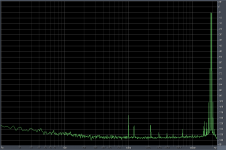
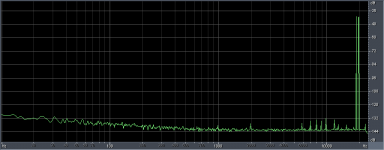
My posted results are using E-MU 0404 USB soundcard. Output DAC is based on AK4396 and input ADC is based on AK5385A; Delta Sigma all the way.
Is this your result?
No, gleaned from a thread on Head-Fi
Indeed not, it would behoove you to invest some time studying how to interpret noise in FFT plots.Looks like AP result. Apparent noise floor is below -150dB, suggestive of more than 24bits. This is likely not the case.
From what I recall AK4396 shows around 15dB noise floor modulation with full scale sinewave wrt -60dB stimulus. Not what I'd call transparent. When you've done your homework on FFTs you could put your new skill to work on the plots AK provide in the eval board notes : figs 9 & 10 pertain.My posted results are using E-MU 0404 USB soundcard. Output DAC is based on AK4396 and input ADC is based on AK5385A; Delta Sigma all the way.
@intgenx - http://www.lavryengineering.com/lavry-white-papers/
Last edited:
@intgenx.
Would this be what you want? The more that vote for it, the more chance of it being developed!
http://lhlabs.com/voice/ideas/11-multichannel-dsd-dac
Would this be what you want? The more that vote for it, the more chance of it being developed!
http://lhlabs.com/voice/ideas/11-multichannel-dsd-dac
No, gleaned from a thread on Head-Fi
Indeed not, it would behoove you to invest some time studying how to interpret noise in FFT plots.
From what I recall AK4396 shows around 15dB noise floor modulation with full scale sinewave wrt -60dB stimulus. Not what I'd call transparent. When you've done your homework on FFTs you could put your new skill to work on the plots AK provide in the eval board notes : figs 9 & 10 pertain.
@intgenx - Lavry Engineering
http://www.akm.com/akm/en/file/ev-board-manual/AK4396VF.pdf, p13 fig10:
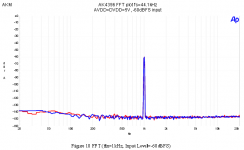
Here is my result:
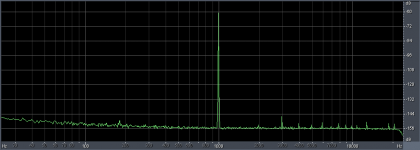
The above is captured by adjusting volume of output and gain of input between DAC and ADC, making better use of 24bits. Based on AKM plots with AP gear, the AP gear isn't all that special.
Here is 1kHz at 0dBFS with 2.333kHz at -60dBFS:
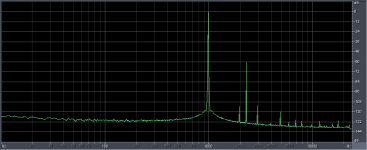
Vast majority can not pick out secondary signal with ears, let alone the really small signals and noise.
Differences in sound quality are microscopic.
Extended listening comparisons, and intensive ABX testing reveal much greater impact from speaker performance than from that of any competently implemented DAC.
Yes, other treacherous test signals may be used that expose modulation artifacts appearing as noise floor.
I am not sure what your 'sinewave wrt -60dB stimulus' is, please clarify.
Extended listening comparisons, and intensive ABX testing reveal much greater impact from speaker performance than from that of any competently implemented DAC.
Since you've been very heavy on claims and provided little or no support for the claims you've made, how about sharing details of the experiments you're referring to here?
I referred to figs 9 and 10 from the evaluation board document for AK43966. I've reproduced them here - compare noise 'floors' between them.I am not sure what your 'sinewave wrt -60dB stimulus' is, please clarify.
Attachments
What of thee noise floors? Essentially they show large v small signal behavior. How do they compare to other circuits; and what are audible differences?
I've done plenty of comparisons of my own, and also participated in ABX testing in threads by PMA and Mooly.
You don't provide any measurements, and ABX results indicating ability to differentiate. Sure, plenty of chatter, and pictures of projects, but no credible measurements.
My posts show credible results for product designed around AKM chips that meet performance results of AKM.
I provide results from experiments.
You claim to be designer, yet provide nothing but crappy result from somebody else's product.
It is trivial to look at noise floors, and see differences. Also trivial to notch out signals, and listened to amplified residuals and hear differences of large signal conditions compared to small signal conditions. These can be used as study practice for different devices, and used as aide in trying to discriminate in ABX testing. Even with such directed ear training, telling devices apart using any semblance of music waveforms becomes impossible for vast majority when real differences are little wiggles in noise floor.
I've done plenty of comparisons of my own, and also participated in ABX testing in threads by PMA and Mooly.
You don't provide any measurements, and ABX results indicating ability to differentiate. Sure, plenty of chatter, and pictures of projects, but no credible measurements.
My posts show credible results for product designed around AKM chips that meet performance results of AKM.
I provide results from experiments.
You claim to be designer, yet provide nothing but crappy result from somebody else's product.
It is trivial to look at noise floors, and see differences. Also trivial to notch out signals, and listened to amplified residuals and hear differences of large signal conditions compared to small signal conditions. These can be used as study practice for different devices, and used as aide in trying to discriminate in ABX testing. Even with such directed ear training, telling devices apart using any semblance of music waveforms becomes impossible for vast majority when real differences are little wiggles in noise floor.
So again, plenty of claims but no experimental details to back up your claim here:
Extended listening comparisons, and intensive ABX testing reveal much greater impact from speaker performance than from that of any competently implemented DAC.
In particular how to distinguish 'competently implemented DAC' s from all DACs out there? To do experiments on 'competently implemented DAC's you'd need a falsifiable description - provide one.
Extended listening comparisons, and intensive ABX testing reveal much greater impact from speaker performance than from that of any competently implemented DAC.
In particular how to distinguish 'competently implemented DAC' s from all DACs out there? To do experiments on 'competently implemented DAC's you'd need a falsifiable description - provide one.
There you go again with passive aggressive, defensive posturing.
Surely you must have rational answer to this question. What would be your basis for building circuits and ascribing superiority over other similar implementations?
In particular how to distinguish 'competently implemented DAC' s from all DACs out there? To do experiments on 'competently implemented DAC's you'd need a falsifiable description - provide one.
Surely you must have rational answer to this question. What would be your basis for building circuits and ascribing superiority over other similar implementations?
There you go again with passive aggressive, defensive posturing.
Yet another claim. Evidence any? Relevance any?
Surely you must have rational answer to this question. What would be your basis for building circuits and ascribing superiority over other similar implementations?
You claim, you have responsibility to support. That's how science works.
- Status
- This old topic is closed. If you want to reopen this topic, contact a moderator using the "Report Post" button.
- Home
- Source & Line
- Digital Line Level
- Ultimate multi-channel DAC
